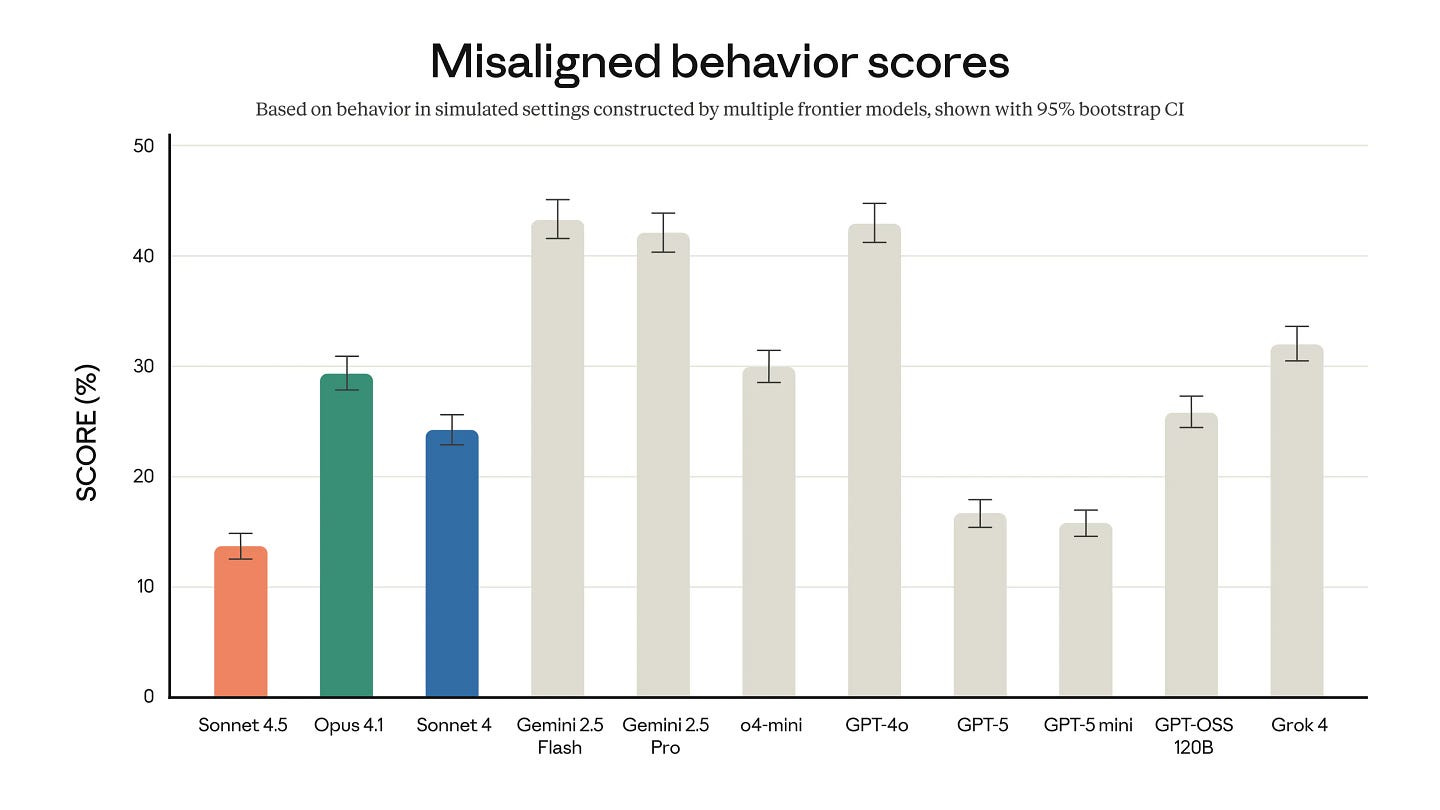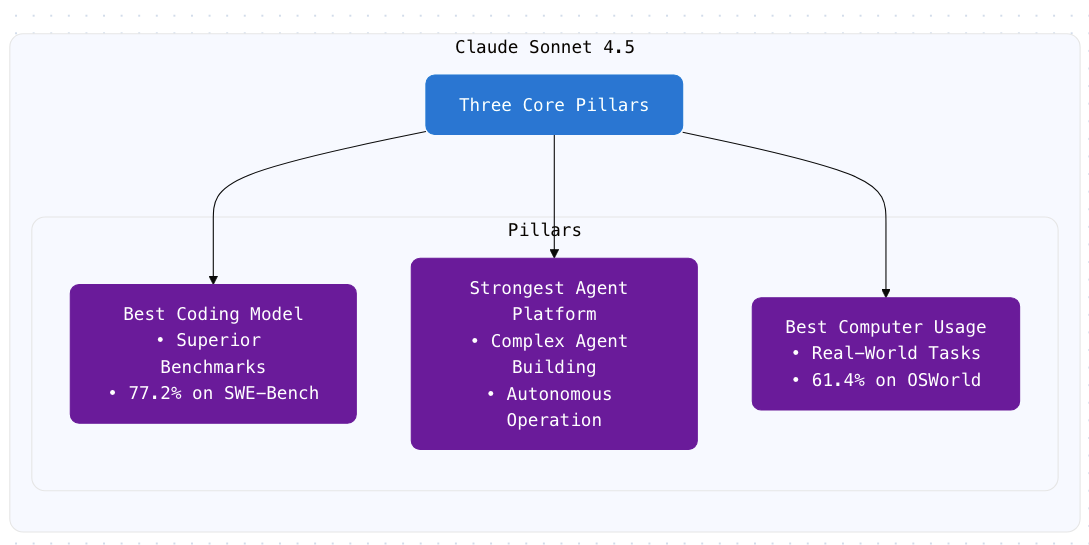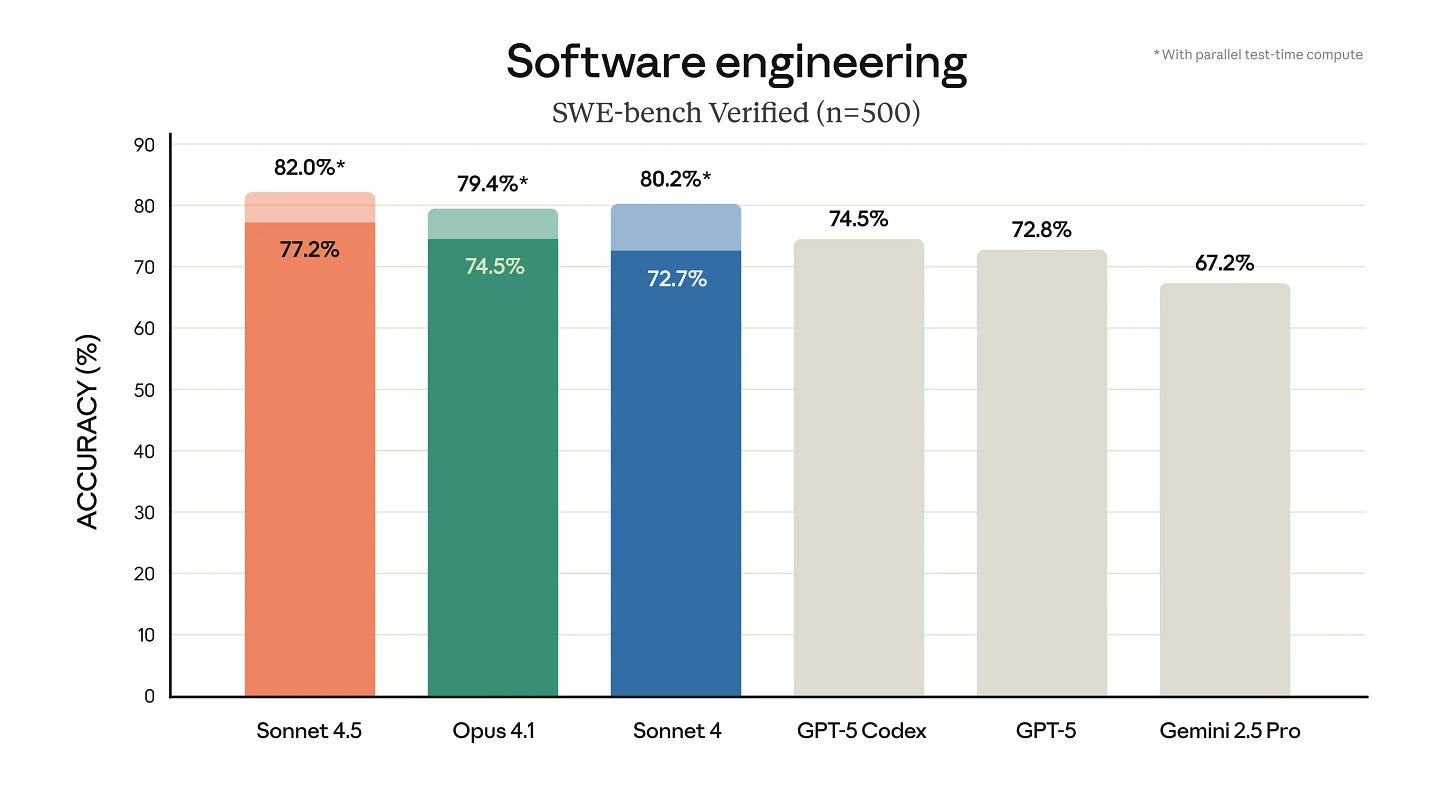Why Claude Sonnet 4.5 Isn't an Incremental Update - But a Strategic Move
An AI that shifts your job from fixing its output to making strategic choices based on it.
Anthropic’s launch narrative is bold, and for good reason. Their “Introducing Claude Sonnet 4.5” page lays out three pillars:
it’s the best coding model in the world,
the strongest for building complex agents,
and the best at using computers.
Here are the standout technical advances:
Superior Benchmarks
On the SWE-Bench Verified evaluation, Sonnet 4.5 takes the lead. On OSWorld, which tests real-task computer use, it makes a massive leap from ~42.2% (Sonnet 4) to ~61.4%.
This isn’t just about getting a better grade; it’s about demonstrating a tangible increase in the model’s ability to perform complex, real-world tasks reliably.
Infrastructure for You to Build With
The Claude Agent SDK is now exposed. This means the same infrastructure powering Anthropic’s own products is available for you to build custom agents. This is a significant shift from providing a model to providing a platform.
Enhanced Developer Experience
Anthropic is introducing checkpoints (so you can roll back agent states), a native VS Code extension, a refreshed terminal, and new context editing/memory tools. These aren’t flashy features; they are foundational tools for serious development.
Improved Safety & Alignment
Anthropic positions 4.5 as its most aligned frontier model yet, with lower rates of sycophancy, deception, and power-seeking. For anyone building products in regulated industries, this isn’t a “nice-to-have,” it’s a core requirement.

Same Pricing, Wider Deployment
You get all this new power for the same price as Sonnet 4. It’s available via the Claude API, Amazon Bedrock, Google’s Vertex AI, and is now rolling into GitHub Copilot.
In short, this isn’t a small increment. It’s an ecosystem upgrade.
What’s Emerging from Early Reviews
While the real-world feedback is just forming, early reviews, particularly the hands-on testing by Nate B. Jones, reveal a clear pattern. Nate noted a “big difference” in the look and feel, one that aligns with Anthropic’s strategy of leaning into “professional AI.”
Here is what’s working well:
Clarity of Narrative
This is the killer feature. Nate found that Sonnet 4.5 produces work (spreadsheets, decks, documents) with such clarity that it’s easy for a human expert to see exactly where to intervene.
He calls it the first model that can go from a “big muddle of customer quotes to an executive-ready narrative arc” in one shot, producing a PowerPoint that is “90% ready to go.” You’re spending less time wading through AI “slop” and more time making high-level decisions.
A “Thoughtful Colleague”
The model feels less like a hyperactive tool and more like a professional partner. Nate highlights its “obsession with checking its work” — catching pixel overlaps in a slide, or validating a dev server could run before reporting success.
It has opinions and will push back, making the interaction feel more like a collaboration. This is a stark contrast to competitors that, as Nate puts it, just “like to say they could do stuff.”
Less Prompt-Sensitive
Unlike models that are highly sensitive to prompt structure, Sonnet 4.5 delivers usable, high-quality outputs from both formal and casual prompts. This lowers the barrier to entry and reduces the time spent on prompt engineering.
What Still Challenges It?
Hallucinations in code
While the structure is smart, it can still invent library-specific calls or misfire on the details — a classic LLM weakness.
Edge cases
For very large or domain-specific codebases, it may still mis-handle imports or fail to reuse existing abstractions.
Context limitations
Even with new memory tools, the fundamental constraints of context size and cost remain a factor in very long-running, complex tasks.
Why This Feels Like a Turning Point?
I see Claude Sonnet 4.5 not just as an upgrade, but as Anthropic’s bet that AI utility at scale must move from toy demos into stable, real-world workflows.
This is a move from “AI as assistant” to “AI as worker.” The focus on agentic infrastructure, developer tools, and alignment signals a push towards autonomous work. Nate B. Jones nailed it when he said this model moves you from a state of productivity to a state of decisioning. It produces a baseline of quality so high that your job shifts from fixing the output to making strategic choices based on it.
Final Thought
To sum it up, Claude Sonnet 4.5 is a powerful inflection point. It’s not perfect, but it’s powerful enough that you should be thinking about re-architecting your AI workflows around it, not simply grafting it on.
What to read between the lines?
Nate is selling experience: does it feel faster, more usable, more fluid
Anthropic is selling evidence: do metrics, alignment, safety, and infrastructure move forward?
You want both. You’ll lean in if the model performs in your stack — not just dazzles in a demo.
Cheers,
Rakia
🎁 I deliver bespoke tech workshops and seminars that:
✨ Make complex topics exciting
✨ Show real-world case studies
✨ Give hands-on with tailored content
✨ Let you leave energized 🚀 not overwhelmed!
Want this energy for yourself or YOUR team? 👉 Reach out or DM me.
Further Reading and Viewing
🎥 The 3 Developer Roles of the Future (that AI can’t replace)
📖 The productivity paradox of AI-assisted coding, by Edgar Kussberg
🎁 Special Gift for You
I’ve got a couple of great offers to help you go even deeper. FREE access to my video courses - available for a limited time, so don’t wait too long!
🔥 Modern Software Engineering: Architecture, Cloud & Security
FREE coupon RAKIA_SOFT_ENG_5🤖 The AI for Software Engineering Bootcamp 2025
FREE coupon AI_ASSISTED_ENG_5🔐 Secure Software Development: Principles, Design, and Gen-AI
FREE coupon RAKIA_SECURE_APPS_5FREE coupon RAKIA_API_DESIGN_5
🐳 Getting Started with Docker & Kubernetes + Hands-On
FREE coupon RAKIA_DOCKER_K8S_5⚡ Master Web Performance: From Novice to Expert
FREE coupon RAKIA_WEB_PERF_5
Want more?
💡 🧠 I share content about engineering, technology, and leadership for a community of smart, curious people. For more insights and tech updates, join my newsletter and subscribe to my YouTube channel.



